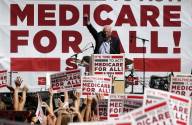
In this Article:
- What are the true causes of inflation?
- How do economic policies impact inflation?
- What lessons can we learn from the 1970s inflation period?
- Why is Biden unfairly blamed for inflation in the 2020s?
- How does media reporting skew public perception of inflation?
Understanding What Really Drives Inflation
by Robert Jennings, InnerSelf.com
Inflation is a topic that has been front and center in the economic discourse for decades, and for good reason. It impacts nearly every aspect of our lives—from the price of groceries to the cost of housing—and shapes the financial stability of individuals, families, and entire nations. Yet, despite its importance, inflation is often misunderstood. It's easy to point fingers and assign blame when prices go up, but the true causes of inflation are far more complex. Blaming government policies alone for inflation, as we often see in the political arena, oversimplifies a much larger picture.
In this article, we'll explore two critical periods of inflation—the 1970s and the post-pandemic period of the 2020s. These timeframes provide valuable insights into how inflation works, why it happens, and why leaders like Presidents Lyndon B. Johnson (LBJ), Jimmy Carter, and Joe Biden have been unfairly blamed for economic conditions that were largely beyond their control. We can understand the economic forces at play by looking at the root causes of inflation in these two periods.
To properly understand why inflation occurs, we must first define it. Inflation, at its core, is the rate at which the general level of prices for goods and services rises, causing the purchasing power of money to decrease. Essentially, your money buys less than it did before. But inflation doesn't occur in a vacuum—there are several types of inflation, each driven by different forces:
Here's a list of factors that have been proven to cause inflation:
- Increased Demand (Demand-Pull Inflation): Prices rise when consumer demand for goods and services exceeds supply.
- Rising Production Costs (Cost-Push Inflation): Increasing raw materials, wages, and other production inputs leads companies to raise prices to maintain profitability.
- Supply Chain Disruptions: Interruptions in the supply chain, such as those caused by natural disasters, pandemics, or geopolitical conflicts, can limit the availability of goods and drive up prices.
- Expansionary Monetary Policy: When central banks increase the money supply or keep interest rates low for extended periods, more money can chase the same amount of goods, resulting in higher prices.
- Government Spending: Large increases in government spending, mainly if funded by borrowing, can inject more money into the economy, leading to higher demand and inflationary pressures.
- Currency Devaluation: When a country's currency loses value relative to other currencies, the cost of imported goods rises, contributing to inflation.
- Expectations of Future Inflation: If businesses and consumers expect prices to rise, they may act in ways that cause inflation, such as demanding higher wages or raising prices preemptively.
- Energy Price Shocks: Sudden increases in energy prices, such as oil, can lead to higher transportation and production costs, often passed on to consumers.
- Wage-Price Spiral (Built-in Inflation): As wages increase to keep up with the cost of living, businesses raise prices to cover higher labor costs, creating a cycle of rising wages and prices.
- Reduced Competition: Monopolization or reduced competition in markets can allow companies to increase prices without fear of losing customers, contributing to inflation.
- Import Tariffs: Tariffs on imported goods can lead to higher prices, contributing to overall inflation, especially if the goods are essential or have few substitutes.
- Supply and Demand Imbalances: Any significant imbalance between supply and demand, whether due to sudden changes in consumer behavior or external shocks, can lead to inflationary pressures.
While domestic policies can influence inflation, they often result from local and global factors. This becomes especially evident when we examine the inflationary periods of the 1970s and 2020s.
Inflation's Lagging Effects and Media Influence
Inflation is not an immediate reaction to economic events or policies; instead, it often needs to catch up to the factors that cause it. This means that the impact of specific policies or global events may not be felt in prices for months or even years after they occur. For example, the effects of expansive monetary policies or significant disruptions like the COVID-19 pandemic take time to ripple through the economy, gradually influencing prices as supply chains adjust and consumer behaviors shift. Similarly, energy price shocks or significant changes in government spending may contribute to inflationary pressures that only become fully apparent long after the initial event.
This lagging nature of inflation can lead to misunderstandings, especially when assessing the effectiveness of economic policies. A policy directly linked to rising prices might have its roots in earlier decisions or external factors that are not immediately obvious. This delay complicates the narrative, allowing political figures to attribute inflation to the current administration, regardless of whether its policies are the actual cause.
Adding to this confusion is the way the media reports on inflation. Often, inflation figures are presented on a year-over-year basis, which compares prices to the same month in the previous year. While this can provide a valuable long-term perspective, it can also exaggerate the perception of inflation if prices had already been high the last year due to specific circumstances. For instance, if prices spiked due to an unusual event like a natural disaster or a pandemic, the year-over-year comparison might show continued high inflation, even if month-over-month increases are minimal or even declining.
In contrast, month-over-month figures provide a more immediate view of how prices change in the short term, but these are less frequently highlighted in media reports. When the public primarily hears year-over-year figures, it can skew their perception, making inflation seem more persistent and severe than it might be. This reporting method can contribute to a heightened sense of economic instability. It may feel unnecessary panic or political blame, overshadowing the nuanced realities of how inflation unfolds over time.
Understanding the lagging effects of inflation and the influence of media reporting is crucial for a more accurate interpretation of economic conditions. It can help move beyond partisan narratives and towards a more informed public discourse.
The 1970s Inflation and the Blame on LBJ and Carter
In the 1970s, the U.S. economy faced a period of stagflation—an economic situation marked by high inflation, high unemployment, and stagnant growth. As prices spiraled out of control, many looked for someone to blame. President Lyndon B. Johnson (LBJ) became an easy target, with critics pointing to his government spending on Medicare, created in 1965, and the escalating costs of the Vietnam War. The argument was simple: increased government spending led to inflation. However, this narrative overlooks critical global factors that were the true culprits of the inflationary surge of the 1970s.
While Medicare and the Vietnam War contributed to government deficits, the oil crisis drove inflation in the 1970s. In 1973, the Organization of Arab Petroleum Exporting Countries (OAPEC) placed an oil embargo on nations that supported Israel during the Yom Kippur War. The result was a quadrupling of oil prices, which sent shockwaves throughout the global economy.
Oil isn't just an energy source; it's a vital input in producing and transporting nearly every good. As oil prices skyrocketed, the cost of everything from gasoline to home heating oil to consumer goods shot up. Petroleum-based products like roofing shingles also saw dramatic price increases. This was classic cost-push inflation, as companies passed these higher costs to consumers. The rising oil prices affected the entire economy, creating inflationary pressures far beyond domestic policy decisions.
President Jimmy Carter, who took office in 1977, inherited an economy already struggling with the inflationary aftermath of the oil crisis. Yet, Carter was also unfairly blamed for continuing inflation throughout his presidency. Carter attempted to address the energy crisis by implementing conservation and alternative energy development policies. Unfortunately, these measures took time to have an effect, and the inflationary pressures continued.
In 1979, Carter appointed Paul Volcker as Chairman of the Federal Reserve, a move that would eventually help bring inflation under control. Volcker implemented a policy of high interest rates to combat inflation, which, while painful in the short term, successfully reduced inflation by the early 1980s. However, the recession accompanying this policy further damaged Carter's political standing, leading to his defeat in the 1980 election. Ironically, the inflation-reducing measures set in motion during Carter's presidency are often credited to his successor, Ronald Reagan.
The Post-Pandemic Inflation Period
The post-pandemic period of the 2020s presents another clear example of how complex the causes of inflation can be. As the global economy shut down in 2020 due to the COVID-19 pandemic, governments worldwide responded with unprecedented fiscal and monetary stimulus measures. In the U.S., the Biden administration, building on policies from the Trump era, implemented a series of stimulus packages to support households and businesses.
These measures, including direct payments to individuals, expanded unemployment benefits, and business loans, were crucial in preventing a total economic collapse. However, inflationary pressures began to build as the world recovered from the pandemic.
A major factor contributing to post-pandemic inflation was the disruption of global supply chains. Due to the pandemic, factories worldwide shut down or operated at reduced capacity, leading to shortages of goods. At the same time, consumer demand surged as economies reopened. This mismatch between supply and demand created inflationary pressures, particularly in the goods sector.
During this period, there was ample evidence of corporate price gouging, especially in industries with reduced competition due to decades of corporate consolidation. Companies with significant market power used the pandemic as an opportunity to increase prices beyond what was justified by supply chain issues, further exacerbating inflation. The lack of competition, resulting from monopolization trends since the 1970s, allowed large corporations to push prices higher without fear of losing market share.
Government Response and Economic Stability
Despite criticisms from some quarters, the government's intervention during the pandemic was essential in preventing a far more damaging economic collapse. Without the stimulus programs, the sudden drop in demand caused by lockdowns and business closures could have led to a deflationary spiral, where prices fall, leading to reduced spending, lower production, and further economic contraction.
In this sense, the government's actions—while they may have contributed to inflation—were a necessary trade-off to avoid a prolonged recession. The U.S. recovery has been more potent than many other nations, with lower unemployment and higher economic growth. Countries with less aggressive fiscal and monetary responses have faced slower recoveries and, in some cases, even higher inflation.
Debunking the Myth It Was Biden's Fault
Blaming Biden and the Democrats for the inflation of the 2020s is reminiscent of the blame placed on LBJ and Carter for the inflation of the 1970s. In both cases, partisan narratives oversimplified the causes of inflation, focusing on government spending while ignoring the more prominent global forces at play.
In the 1970s, the oil crisis—not domestic spending—was the primary driver of inflation. Similarly, in the 2020s, global supply chain disruptions and energy price shocks, exacerbated by the war in Ukraine, were significant contributors to inflation. These issues were mainly beyond any single government's control and were felt worldwide.
It's also important to understand that government policies, while they may contribute to inflationary pressures in the short term, are often necessary to maintain economic stability. Without the fiscal stimulus provided by the U.S. government during the pandemic, millions of Americans could have fallen into poverty, and countless small businesses would have gone under.
Moreover, monetary policy—controlled by the Federal Reserve—plays a significant role in managing inflation. During the post-pandemic period, the Fed kept interest rates low to stimulate the economy. While this may have contributed to inflation, it also helped to foster a more robust economic recovery. The same can be said for Carter's appointment of Volcker, whose high-interest rate policies eventually tamed inflation but came with short-term financial pain.
Lessons Learned and Moving Forward
The 1970s and the 2020s inflationary periods offer important lessons for policymakers and the public alike. First, we must recognize that complex, global factors often drive inflation beyond any single administration's policies. Blaming leaders like LBJ, Carter, or Biden without acknowledging these broader forces is unfair and counterproductive. It shifts focus away from the natural causes and prevents a deeper understanding of how to manage and mitigate inflation in the future.
Second, it's crucial to understand the role of government intervention in maintaining economic stability. While government spending can contribute to inflation, it can also prevent far more damaging economic outcomes, such as deflationary spirals or prolonged recessions. The challenge for policymakers is to balance the need for financial support with strategies to manage inflation effectively.
Finally, these periods remind us of the importance of robust competition in the economy. The increased monopolization of industries since the 1970s has allowed some corporations to engage in price gouging during times of crisis, exacerbating inflationary pressures. Addressing these issues through vigorous antitrust enforcement and promoting competition can help prevent such scenarios.
Inflation is a complex and multifaceted economic phenomenon that requires careful analysis and understanding. The experiences of the 1970s and the post-pandemic period of the 2020s demonstrate that simplistic explanations, such as blaming government spending or specific leaders, fail to capture the true causes of inflation.
It's essential to recognize that the political narrative surrounding inflation often skews towards partisanship, with Republicans typically blaming Democrats for rising prices. This tendency overlooks the complexity of inflation, which is influenced by myriad factors beyond any single administration's control. By focusing on partisan blame, we risk oversimplifying the issue and missing the broader economic forces at play, which are often driven by global events and structural factors rather than solely by domestic policies. Understanding this complexity is crucial for developing practical solutions beyond political finger-pointing.
Article Recap:
This article covers the causes of inflation and the role of economic policy, drawing comparisons between the 1970s and the post-pandemic period. It examines how global events, supply chain issues, and government interventions contribute to inflation while exploring how media reporting affects public perception.
About the Author
 Robert Jennings is co-publisher of InnerSelf.com with his wife Marie T Russell. He attended the University of Florida, Southern Technical Institute, and the University of Central Florida with studies in real estate, urban development, finance, architectural engineering, and elementary education. He was a member of the US Marine Corps and The US Army having commanded a field artillery battery in Germany. He worked in real estate finance, construction and development for 25 years before starting InnerSelf.com in 1996.
Robert Jennings is co-publisher of InnerSelf.com with his wife Marie T Russell. He attended the University of Florida, Southern Technical Institute, and the University of Central Florida with studies in real estate, urban development, finance, architectural engineering, and elementary education. He was a member of the US Marine Corps and The US Army having commanded a field artillery battery in Germany. He worked in real estate finance, construction and development for 25 years before starting InnerSelf.com in 1996.
InnerSelf is dedicated to sharing information that allows people to make educated and insightful choices in their personal life, for the good of the commons, and for the well-being of the planet. InnerSelf Magazine is in its 30+year of publication in either print (1984-1995) or online as InnerSelf.com. Please support our work.
Creative Commons 4.0
This article is licensed under a Creative Commons Attribution-Share Alike 4.0 License. Attribute the author Robert Jennings, InnerSelf.com. Link back to the article This article originally appeared on InnerSelf.com
Recommended books:
Capital in the Twenty-First Century
by Thomas Piketty. (Translated by Arthur Goldhammer)
 In Capital in the Twenty-First Century, Thomas Piketty analyzes a unique collection of data from twenty countries, ranging as far back as the eighteenth century, to uncover key economic and social patterns. But economic trends are not acts of God. Political action has curbed dangerous inequalities in the past, says Thomas Piketty, and may do so again. A work of extraordinary ambition, originality, and rigor, Capital in the Twenty-First Century reorients our understanding of economic history and confronts us with sobering lessons for today. His findings will transform debate and set the agenda for the next generation of thought about wealth and inequality.
In Capital in the Twenty-First Century, Thomas Piketty analyzes a unique collection of data from twenty countries, ranging as far back as the eighteenth century, to uncover key economic and social patterns. But economic trends are not acts of God. Political action has curbed dangerous inequalities in the past, says Thomas Piketty, and may do so again. A work of extraordinary ambition, originality, and rigor, Capital in the Twenty-First Century reorients our understanding of economic history and confronts us with sobering lessons for today. His findings will transform debate and set the agenda for the next generation of thought about wealth and inequality.
Click here for more info and/or to order this book on Amazon.
Nature's Fortune: How Business and Society Thrive by Investing in Nature
by Mark R. Tercek and Jonathan S. Adams.
 What is nature worth? The answer to this question—which traditionally has been framed in environmental terms—is revolutionizing the way we do business. In Nature’s Fortune, Mark Tercek, CEO of The Nature Conservancy and former investment banker, and science writer Jonathan Adams argue that nature is not only the foundation of human well-being, but also the smartest commercial investment any business or government can make. The forests, floodplains, and oyster reefs often seen simply as raw materials or as obstacles to be cleared in the name of progress are, in fact as important to our future prosperity as technology or law or business innovation. Nature’s Fortune offers an essential guide to the world’s economic—and environmental—well-being.
What is nature worth? The answer to this question—which traditionally has been framed in environmental terms—is revolutionizing the way we do business. In Nature’s Fortune, Mark Tercek, CEO of The Nature Conservancy and former investment banker, and science writer Jonathan Adams argue that nature is not only the foundation of human well-being, but also the smartest commercial investment any business or government can make. The forests, floodplains, and oyster reefs often seen simply as raw materials or as obstacles to be cleared in the name of progress are, in fact as important to our future prosperity as technology or law or business innovation. Nature’s Fortune offers an essential guide to the world’s economic—and environmental—well-being.
Click here for more info and/or to order this book on Amazon.
Beyond Outrage: What has gone wrong with our economy and our democracy, and how to fix it -- by Robert B. Reich
 In this timely book, Robert B. Reich argues that nothing good happens in Washington unless citizens are energized and organized to make sure Washington acts in the public good. The first step is to see the big picture. Beyond Outrage connects the dots, showing why the increasing share of income and wealth going to the top has hobbled jobs and growth for everyone else, undermining our democracy; caused Americans to become increasingly cynical about public life; and turned many Americans against one another. He also explains why the proposals of the “regressive right” are dead wrong and provides a clear roadmap of what must be done instead. Here’s a plan for action for everyone who cares about the future of America.
In this timely book, Robert B. Reich argues that nothing good happens in Washington unless citizens are energized and organized to make sure Washington acts in the public good. The first step is to see the big picture. Beyond Outrage connects the dots, showing why the increasing share of income and wealth going to the top has hobbled jobs and growth for everyone else, undermining our democracy; caused Americans to become increasingly cynical about public life; and turned many Americans against one another. He also explains why the proposals of the “regressive right” are dead wrong and provides a clear roadmap of what must be done instead. Here’s a plan for action for everyone who cares about the future of America.
Click here for more info or to order this book on Amazon.
This Changes Everything: Occupy Wall Street and the 99% Movement
by Sarah van Gelder and staff of YES! Magazine.
 This Changes Everything shows how the Occupy movement is shifting the way people view themselves and the world, the kind of society they believe is possible, and their own involvement in creating a society that works for the 99% rather than just the 1%. Attempts to pigeonhole this decentralized, fast-evolving movement have led to confusion and misperception. In this volume, the editors of YES! Magazine bring together voices from inside and outside the protests to convey the issues, possibilities, and personalities associated with the Occupy Wall Street movement. This book features contributions from Naomi Klein, David Korten, Rebecca Solnit, Ralph Nader, and others, as well as Occupy activists who were there from the beginning.
This Changes Everything shows how the Occupy movement is shifting the way people view themselves and the world, the kind of society they believe is possible, and their own involvement in creating a society that works for the 99% rather than just the 1%. Attempts to pigeonhole this decentralized, fast-evolving movement have led to confusion and misperception. In this volume, the editors of YES! Magazine bring together voices from inside and outside the protests to convey the issues, possibilities, and personalities associated with the Occupy Wall Street movement. This book features contributions from Naomi Klein, David Korten, Rebecca Solnit, Ralph Nader, and others, as well as Occupy activists who were there from the beginning.
Click here for more info and/or to order this book on Amazon.













